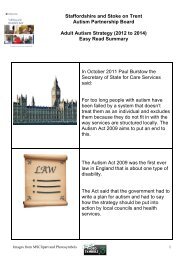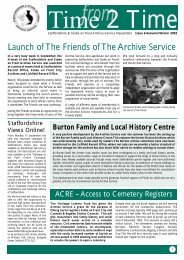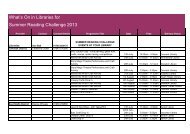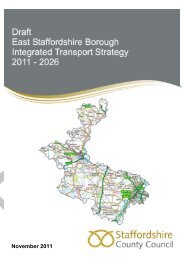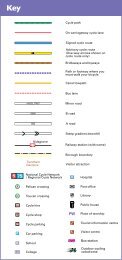nationalCommunitySafetyPlan200811 - Staffordshire County Council
nationalCommunitySafetyPlan200811 - Staffordshire County Council
nationalCommunitySafetyPlan200811 - Staffordshire County Council
You also want an ePaper? Increase the reach of your titles
YUMPU automatically turns print PDFs into web optimized ePapers that Google loves.
18 NATIONAL COMMUNITY SAFETY PLAN 2008–11<br />
What does it mean for the public?<br />
Fewer young people will experience poor outcomes,<br />
and instead will make a successful transition to<br />
adult life.<br />
What does it mean for partnerships?<br />
Children’s trusts bring together social services, health,<br />
education and other services for children and young<br />
people in a local authority area, and have the lead<br />
role in local delivery of this PSA. Similarly, YOTs<br />
bring together key partners to tackle youth crime and<br />
reoffending, and have a lead role in the delivery of<br />
the indicator to reduce fi rst-time entrants into the<br />
CJS aged 10–17. Given the role of early intervention<br />
in preventing future crime and tackling youth crime,<br />
and the contribution that this makes to the Make<br />
communities safer PSA, CDRPs have a particular<br />
interest in working closely with both children’s trusts<br />
and YOTs. In line with local priorities and strategic<br />
assessments, CDRPs should consider:<br />
■ working closely with children’s trusts and YOTs,<br />
and involving the third sector, to develop robust<br />
Children and Young People’s Plans (incorporating<br />
Youth Justice Plans), maximising opportunities<br />
to reach the most socially excluded young people,<br />
particularly those at risk of entering the CJS;<br />
■ engaging children and young people to understand<br />
their concerns and priorities, and developing<br />
responses through the partnership plan;<br />
■ working with the police to consider using Safer<br />
Schools Partnerships to build good relationships<br />
between the police, children and young people;<br />
improve the safety of young people; and tackle<br />
youth crime; and<br />
■ working closely with children’s trusts and primary<br />
care trusts (particularly those that do not pool<br />
budgets with their local partners) to ensure that<br />
there is suffi cient availability of appropriate mental<br />
health services for 16 and 17 year olds (many of<br />
those involved in crime have substance misuse<br />
and/or mental health issues).<br />
What does it mean nationally and regionally?<br />
■ The Home Offi ce, the Department for Children,<br />
Schools and Families (DCSF) and the Ministry of<br />
Justice will work with the Police Service and other<br />
partners to develop a youth crime action plan and<br />
practitioner toolkit (to be published in spring 2008).<br />
■ Government Offi ces have a key role to play in<br />
ensuring that community safety is integral to<br />
strategy, planning and delivery in local areas.<br />
Government Offi ces provide support to and<br />
challenge local areas, disseminate effective practice<br />
and facilitate meaningful collaboration across<br />
partnerships to tackle the full range of crime and<br />
disorder issues. (In Wales, this is the responsibility<br />
of the Home Offi ce Crime Team.)<br />
CASE STUDY<br />
Safer Schools Partnership. In autumn 2002,<br />
levels of criminal damage and nuisance calls started<br />
to increase in and around Henbury School. The<br />
perpetrators were found to be local young people<br />
coming onto the school site after school. On<br />
speaking with the young people it was found that<br />
the school was seen as a safe place to play, but older<br />
young people would often follow and use the site to<br />
drink alcohol and smoke, leading to the damage and<br />
increase in nuisance behaviour. As a result, the Safer<br />
Schools Partnership set up an after-school club at<br />
the school. The programme of activities including<br />
art, sport, music and community projects, aiming<br />
to provide a safe, supervised play environment<br />
where young people could learn and develop their<br />
interpersonal skills: a priority was to challenge<br />
inappropriate behaviour. A target group of young<br />
people was actively involved in taking ownership of<br />
the club, developing it and challenging the behaviour<br />
of other young people. After three months, there<br />
was a distinct decrease in the levels of criminal<br />
damage. After 12 months, evaluation revealed<br />
increasing levels of acceptable behaviour, levels of<br />
criminal damage at an all-time low, and increased<br />
interest and involvement from parents as well as<br />
young people.



